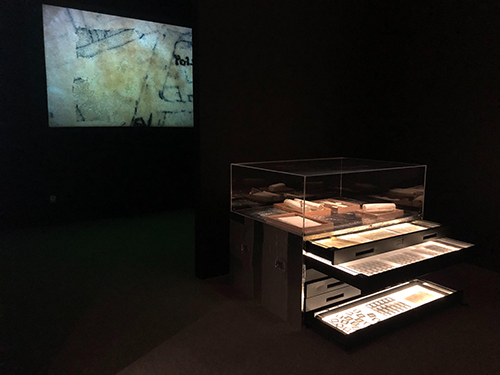藝術家謝淑婷早年在中文大學修讀藝術系,在自由的學術環境與師友間交流下,學習一個人如何面對創作,理解不同媒介的相通性,成為她往後創作的養份和取向。畢業後她到日本交流及在樂天陶社工作,並做了畢業後第一個個展- Pottermaid,「成立」手造拉坯腳踏輔助器的公司,當時別人的不理解讓她確立了自己的獨特方向。往後十年間,她默默在火炭埋頭創作,以舊物浸泥漿而燒成的白瓷物成為了她的標誌性作品之一。其創作的媒材亦不止於陶瓷,善於挪用不同的現成物再轉化。私密故事的實物因高溫燒成後消失,可是瓷泥卻讓故事保存下來,易碎的白瓷呈現著生命的脆弱。作品像樹洞般釋放著她的情感和秘密,她透過創作去修補及梳理與家人的關係。她過往的作品曾入選雙年獎、也得到法國駐留及畫廊展覽的機會,展出了一件又一件回憶物件。近年,Sara改變了作品呈現方式,雖然她繼續沿用紙白瓷創作,她卻將秘密書信混合於泥漿中以製作紙瓷片,透簿的瓷片在幻燈片下呈現歷史書信及香港地圖等元素,混合不同媒介敘述故事。
Sara Tse Suk Ting graduated with BA (Hons) in Fine Arts from the Chinese University of Hong Kong. The free academic atmosphere nurtures collaborative exchange between peers and teachers. This sharpens her comprehension of the linkage between media which lays the foundation of her creative journey. Upon graduation, she joined the Artist in Residency of Ceramic Art in Tokoname and worked in The Pottery Workshop. She was awarded by her workplace to hold her first solo exhibition — Pottermaid, where she “established” a company of throwing equipment. The misunderstanding of audiences at that time however encouraged her future unique practice. For the next decade, Sara completely immersed herself in ceramics practice at Fotan studio. Fascinated by the transience of time and the impermanence of life, the transformation of daily objects into porcelain became one of her signature works. Moreover, she installed different ready-made objects as footnotes for the sentimental content of her pieces. The physical objects of the intimate stories vanished after firing, but the porcelain body retains her fond memories from childhood to motherhood. Her works present an examination of the fragility of life. They are also her emotional vehicles that aid in repairing the relationship with her family. Her works have been awarded by the Hong Kong Art Biennial Exhibition and exhibited in different international museums and galleries.Recently, Sara has shifted her focus to the cartography of narratives of colonies and historical issues. Paying tribute to the hand-painted maps, she makes ceramics paper-tiles resembling them. Slides of paper tiles embedded with historical documents and local maps magnified under the projector, revealing the nuanced but truthful imperfections of the firing process.





